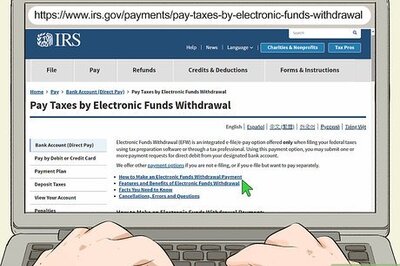
views
The Reserve Bank of India (RBI) kept its key interest rate unchanged on Wednesday but took the first step towards a rate cut as it eased its relatively hawkish policy stance to ‘neutral’. The decision is seen by the real estate sector as a missed opportunity by the RBI to boost housing demand.
Although the repo rate has remained constant since February 2023, the possibility of a rate change by the central bank in the next 3-6 months cannot be ruled out.
Realtors’ apex body Credai said the RBI should have cut key interest rates to boost housing demand during the current festive season and demanded that the apex bank consider lowering the repo rate in the next meeting.
Will ‘Neutral Stance’ Pave Way For Cut In Home Loan Interest Rates?
Atul Monga, Co-founder and CEO, BASIC Home Loans, suggested that the RBI’s move towards a ‘neutral stance’ indicates a careful approach to managing the economy.
While this shift does not guarantee lower home loan interest rates, it does create the potential for rate adjustments based on future inflation trends and overall economic performance, Monga highlighted.
Monga underlined that if inflation remains under control and economic conditions are stable, there’s a good possibility that the RBI may lower repo rates in future meetings.
“This could result in lower home loan interest rates and reduced EMIs by December 2024,” Monga hoped.
Realtors’ body Naredco President G Hari Babu also suggested that the RBI should consider reducing rates in the next MPC meeting.
Role Of Banks Is Important
The actual impact on home loan rates would largely depend on how swiftly banks pass on rate cuts to borrowers, Monga pointed out.
Factors like credit demand and individual bank policies will also influence how quickly the EMIs might decrease.
“Borrowers must stay informed about these developments in order to take advantage of potential savings on their home loans.”
Mixed Outlook For Indian Real Estate
Hitesh Uppal, Head of Finance, Magicbricks stated that the RBI’s decision to keep interest rates unchanged amidst inflation concerns and global uncertainties presents a mixed outlook for the Indian real estate sector.
On one hand, stable rates create a favourable borrowing environment for homebuyers and developers, boosting market confidence and helping control inflation-related cost pressures.
However, this also tempers expectations for more affordable financing, which could slow buyer momentum.
“By not reducing rates now, the RBI limits its ability to lower them in future crises, potentially restricting critical support for the sector,” Uppal added.
How Does Repo Rate Impact On Home Loan?
Impact on Interest Rates:
Repo Rate Cut: When the RBI lowers the repo rate, it becomes less expensive for commercial banks to borrow from the central bank. This reduction often leads banks to decrease the interest rates on loans, including home loans. As a result, borrowers benefit from lower EMIs (Equated Monthly Instalments), making home ownership more affordable.
Repo Rate Hike: On the other hand, if the RBI raises the repo rate, the cost for banks to borrow increases. To offset this, banks usually raise their lending rates, including those for home loans. This leads to higher EMIs for borrowers with floating-rate loans and higher interest rates for new borrowers.
Fluctuations in interest rates have a direct impact on real estate demand. Lower rates tend to boost demand by making loans more accessible, often driving up property prices. In contrast, higher rates generally suppress demand, leading to a softening of property prices.















Comments
0 comment